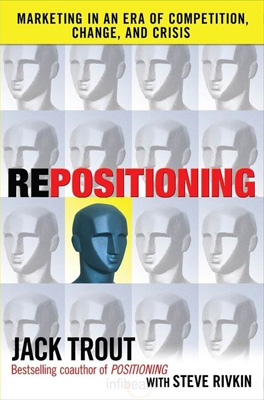Repositioning Speed Summary: Marketing in an Era of Competition, Change, and Crisis

 Repositioning: Marketing in an Era of Competition, Change, and Crisis
Repositioning: Marketing in an Era of Competition, Change, and Crisis- Author: Jack Trout with Steve Rivkin
- Publisher: McGraw-Hill
- Publication: 2010
Three decades after igniting a revolution in marketing by coining and developing the concept of “positioning” in “Positioning: The Battle for Your Mind”, Jack Trout publishes his take on repositioning.
Positioning and Repositioning
Positioning is how you differentiate yourself in the mind of the consumer.
Repositioning is how you re-adjust the way you differentiate yourself in the mind of the consumer – in the face of competition, change or crisis.
In practice, both positioning and repositioning are essentially the same; the process of gaining ownership of a simple word or phrase in the mind of the consumer that is true, differentiating and compelling. Postioning is about creating that ownership, repositioning is about adjusting it.
And how do brands get to own or readjust that word or phrase in the mind of the consumer? A combination of product experience, word of mouth, PR and advertising.
The Art of the Obvious & The Power of Simplicity
Building on his previous book, “In Search of The Obvious: The Antidote for Today’s Marketing Mess“, Trout warns us not to overcomplicate repositioning exercises.
Essentially, repositioning is the art of the obvious – searching for that simple, credible, differentiating idea you want associated with your brand, and making that real in all your marketing.
Simplicity here, according to Trout, is the key to success; the best repositioning involves owning a single differentiating word in the mind of the consumer. Like good positioning ideas, good repositioning ideas will be obvious;
- This problem, when solved, will be simple.
- Does it check with human nature? The obvious matches existing perceptions.
- Put it on paper. If the explanation becomes long, involved or ingenious, then very likely it is not obvious.
- Does it explode in people’s minds? Do people say, “Now why didn’t we think of that before?”
- Is the time ripe? The timeliness of an idea is often as important as the idea itself
Stop Navel-Gazing: Differentiate or Die
Drawing from another of his marketing bestsellers, “Differentiate or Die“, Trout recommends that every repositioning exercise should start with the competition in the mind.
Too many brands run repositioning exercises based on what they want to be – based on some new consumer insight, rather than on how they are different from the market leader. This is a mistake.
Ultimately, successful repositioning should be about repositioning yourself against the market leader – or if you are the market leader – the product or service that you want your brand to replace. In other words, repositioning is about competitive differentiation. Think Avis – “We Try Harder” or “Our Lines are Shorter,” or US restaurant chain Denny’s that hung “candy breakfast” on its competitors, in order to own “real breakfast”.
Although repositioning exercises often have the goal of making a brand more popular (again), Trout warns brands against repositioning too broadly – trying to be all things to all men. In today’s cluttered market, if a repositioning is not differentiating and polarizing it is useless. It’s as much about being who you are NOT for, as who you are for.
Risk-Reduction
The reason why repositioning is essentially all about you and the market leader is that consumers have a natural ‘safety-in-numbers’ bias toward the market leader – and evaluate all alternatives against that leader.
We love underdogs, but we buy from perceived leaders.
But the consumer tendency to benchmark everything against the market leader is a risk-reduction strategy that marketers can turn against market leaders. How? By positioning themselves as the solution to the principal weakness(es) of the market leader.
- 1. Monetary Risk (There’s a chance I could lose money)
- 2. Functional Risk (Maybe it won’t work, or do what it’s supposed to do)
- 3. Physical Risk (It could be dangerous – someone could get hurt)
- 4. Social Risk (What would my peers think?)
- 5. Psychological Risk (It might make me feel guilty or irresponsible)
In other words repositioning is often about attacking a weakness in market leader that you promote as your strength.
For example, Stolichnaya vodka hung “American made” on its U.S. competitors who were “making believe they were Russian.” It was setting up “the Russian vodka” as its positive idea.
A 360 Process
Repositioning involves a concerted and coordinated approach from every element of the communication mix, not only advertising.
In fact, Trout argues that publicity and PR are the key to successful repositioning – because re-adjusting perceptions is tough to do without third-party advocacy of the new positioning. According to Trout, repositioning should be a PR-led exercise: The basic rule is: publicity first, advertising second. Remember this metaphor: PR plants the seed. Advertising harvests the crop.
In a Nutshell
Summing up his views on repositioning, Trout offers four rules for repositioning success
- 1. Find out what position you already have in your consumer’s mind.
- 2. Adopt a repositioning strategy that you want to own. Zero in on the specific concept that you want to achieve and use it to inform all your marketing.
- 3. Convince everyone to concentrate exclusively on this one repositioning approach.
- 4. Measure your efforts – with consumer research – and remember, readjusting perceptions takes time and patience.
And if you remember just one thing, repositioning is as much about who you’re not, as it is as who you are.




